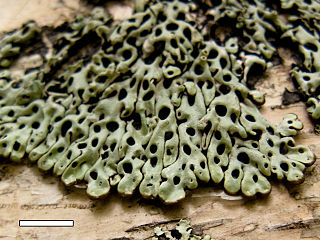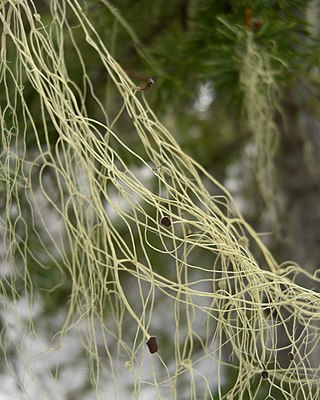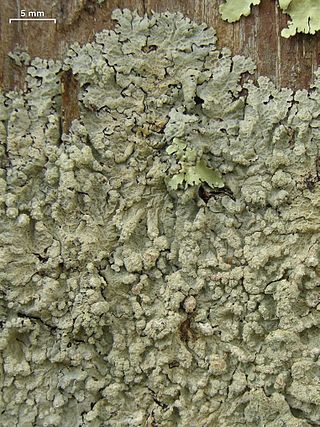
Parmelia is a genus of medium to large foliose lichens. It has a global distribution, extending from the Arctic to the Antarctic continent but concentrated in temperate regions. There are about 40 species in Parmelia. In recent decades, the once large genus Parmelia has been divided into a number of smaller genera according to thallus morphology and phylogenetic relatedness.

The Parmeliaceae is a large and diverse family of Lecanoromycetes. With over 2700 species in 71 genera, it is the largest family of lichen-forming fungi. The most speciose genera in the family are the well-known groups: Xanthoparmelia, Usnea, Parmotrema, and Hypotrachyna.

Ahtiana is a genus of lichenized fungi known as candlewax lichens in the family Parmeliaceae. A monotypic genus, it contains the single species Ahtiana sphaerosporella or the mountain candlewax lichen, found in western North America. This species was segregated from the genus Parmelia by Canadian lichenologist Trevor Goward in a 1985 publication. It had been suggested that the genus include A. aurescens and A. pallidula based on similarities in morphology, but this transfer is not supported by molecular analysis.

Allocetraria is a genus of lichenized fungi in the family Parmeliaceae. It consists of 12 species, with a center of distribution in China.

Arctocetraria is a genus of foliose lichens in the family Parmeliaceae. It has three species.

Hypogymnia is a genus of foliose lichens in the family Parmeliaceae. They are commonly known as tube lichens, bone lichens, or pillow lichens. Most species lack rhizines that are otherwise common in members of the Parmeliaceae, and have swollen lobes that are usually hollow. Other common characteristics are relatively small spores and the presence of physodic acid and related lichen products. The lichens usually grow on the bark and wood of coniferous trees.

Nephromopsis is a genus of lichenized fungi within the Parmeliaceae family.

Parmotrema is a genus of lichen belonging to the family Parmeliaceae. It is a large genus, containing an estimated 300 species, with a centre of diversity in subtropical regions of South America and the Pacific Islands.

Punctelia is a genus of foliose lichens belonging to the large family Parmeliaceae. The genus, which contains about 50 species, was segregated from genus Parmelia in 1982. Characteristics that define Punctelia include the presence of hook-like to thread-like conidia, simple rhizines, and point-like pseudocyphellae. It is this last feature that is alluded to in the vernacular names speckled shield lichens or speckleback lichens.

Xanthoparmelia is a genus of foliose lichen in the family Parmeliaceae. Xanthoparmelia is synonymous with Almbornia, Neofuscelia, Chondropsis, Namakwa, Paraparmelia, and Xanthomaculina. This genus of lichen is commonly found in the United States, as well as Australia, New Zealand and Ecuador.
Everniopsis is a fungal genus in the family Parmeliaceae. It consists of a single species, the bark-dwelling lichen Everniopsis trulla, which occurs in Africa and South America.

Menegazzia is a genus of lichenized fungi containing roughly 70 accepted species. The group is sometimes referred to as the tree flutes, honeycombed lichens, or hole-punch lichens. The most obvious morphological feature of the genus is the distinctive perforations spread across the upper side of the thallus. This makes the group easy to recognise, even for those not particularly familiar with lichen identification.

Allantoparmelia is a genus of lichenised fungi in the large family Parmeliaceae. It is a genus of only three currently accepted species. All three Allantoparmelia lichens have a foliose growth form. They appear to be a very slow growing group of lichens, with a mean annual thallus diameter increase of only 0.23–0.35 mm per year.

Bryoria is a genus of lichenized fungi in the family Parmeliaceae. Many members of this genus are known as horsehair lichens. The genus has a widespread distribution, especially in boreal and cool temperate areas.

Alectoria is a genus of fruticose lichens belonging to the family Parmeliaceae.
André Aptroot is a Dutch mycologist and lichenologist.

Crespoa is a genus of five species of lichen in the family Parmeliaceae. Species in this genus are characterized by having an upper thallus surface that is wrinkled and reticulately ridged to coarsely foveolate.
Helge Thorsten Lumbsch is a German-born lichenologist living in the United States. His research interests include the phylogeny, taxonomy, and phylogeography of lichen-forming fungi; lichen diversity; lichen chemistry and chemotaxonomy. He is the Associate Curator and Head of Cryptogams and Chair of the Department of Botany at the Field Museum of Natural History.
Parmelia ambra is a fossilised species of foliose lichen in the family Parmeliaceae. Found in Dominican amber and described as a new species in 2000, the fossil has been used in subsequent studies of lichen evolution.
Mark Richard David Seaward is a British ecologist and lichenologist. He was awarded the Acharius Medal in 2006 for lifetime contributions to lichenology.















